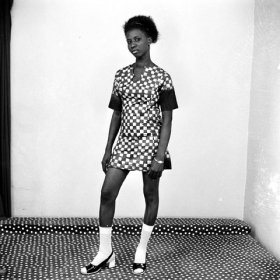Malick Sidibe'
dal 12/6/2008 al 14/10/2008
Segnalato da
12/6/2008
Malick Sidibe'
Foam Photography Museum, Amsterdam
Centrepiece of the show is a series of original chemises, coloured sheets of card on which Sidibe' pasted small prints of the photos he took at parties and events in Bamako, the capital of Mali. Partygoers were able to view and order copies of photos after the event. The chemises displayed here are accompanied by numerous portraits taken by Sidibe' in the 1970s at his studio in Bagadadji.

This summer Foam presents a unique work by the celebrated Malinese photographer Malick Sidibé (b. 1935). Sidibé is the eminence grise of African photography and one of the first African photographers to win recognition in the West for his work. Centrepiece of the show is a series of original chemises, coloured sheets of card on which Sidibé pasted small prints of the photos he took at parties and events in Bamako, the capital of Mali. Partygoers were able to view and order copies of photos after the event. The chemises displayed here date from between 1962 and 1973. They are accompanied by numerous portraits taken by Sidibé in the 1970s at his studio in Bagadadji, a working-class area of Bamako. Together the displays offer a unique and often heart-warming insight into Malinese society in the early years following independence.
Malick Sidibé received a Golden Lion for Lifetime Achievement for his entire oeuvre at the Venice Biennale of 2007. This year Sidibé was also honoured by the International Centre for Photography (ICP) in New York with their 24th Lifetime Achievement Award.
Malick Sidibé was born in 1935 in Soloba, near Bamako (Mali). He was the only child in the family to be sent to Bamako to study at the Ecole des Artisans Soudanais. Gérard Guillat, a French photographer living in Mali, took Malick on as an assistant. From Guillat, Sidibé was able to learn the basic skills of photography. He earned his living by taking photos at parties given by the young people of Bamako’s middle classes.
When Sidibé set up for himself in 1962 he soon became a popular photographer at parties and events in Bamako: from football games, weddings and baptisms to dance festivities and Christmas celebrations. Especially remarkable are the photos he took at the so-called surprise parties organised by the young Malinese themselves. They had formed into a series of clubs which they named after their favourite pop idol or record (Los Cubanos, Les Las Vegas, Les Caïds). Sidibé covered as many as five events a night before retreating to his darkroom to develop the negatives. He would then paste prints of the photos onto cards and display these so the partygoers would be able to view and select the ones they wanted.
In the mid-1970s, Sidibé moved into a new area of work, confining himself to studio portraiture and the repair of cameras. Over 1,000 of his chemises have survived. Some have been bought up by private collectors, but most still remain at Studio Malick in Bamako. This collection is a unique historical record of Malinese society.
The exhibition was made possible with the support of Gwinzegal. It is accompanied by a publication entitled ‘Malick Sidibé – Chemises’, published by Steidl. In collaboration with NCDO and the Prince Claus Fund.
Foam is supported by de BankGiro Loterij and the VandenEnde Foundation.
FOAM Photography Museum
Keizersgracht 609 - Amsterdam



